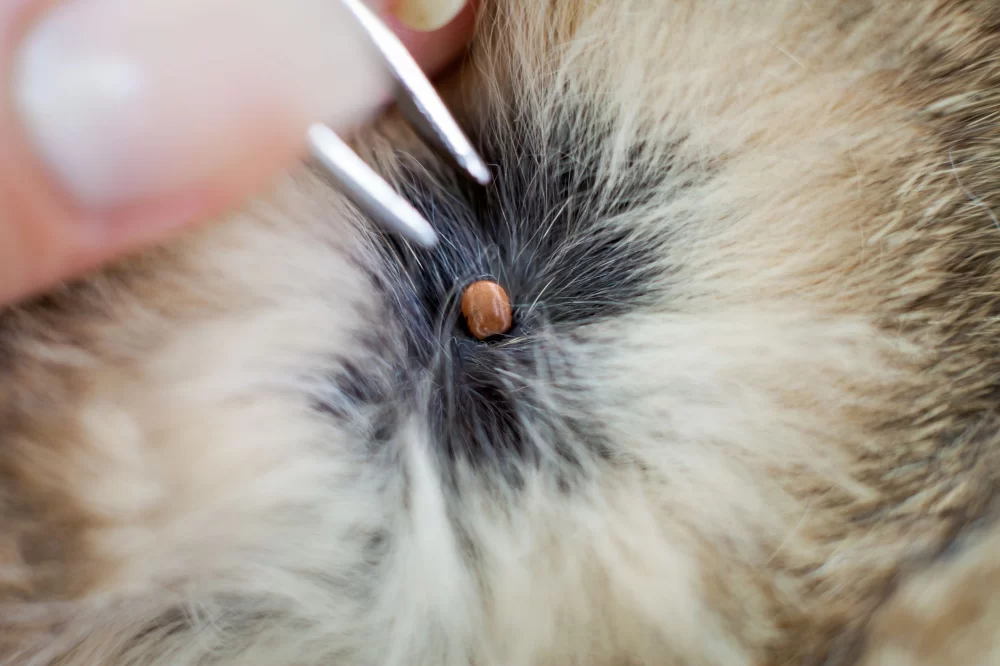- Understanding Fleas and Ticks on Pets
- Recognizing Visible Signs of Fleas and Ticks
- Behavioral Changes Indicating Flea or Tick Infestation
- Health Consequences of Fleas and Ticks
- Real Case Example: Flea Infestation on a Cat
- Expert Advice on Prevention and Treatment
- How Hidden Brook Veterinary Can Help
1. Understanding Fleas and Ticks on Pets
Fleas and ticks are two of the most common external parasites that affect dogs and cats worldwide. These tiny creatures not only cause discomfort but can also transmit serious diseases. Fleas are small, wingless insects that thrive by feeding on the blood of their hosts, often causing intense itching and skin irritation. Ticks, on the other hand, are arachnids that attach firmly to the skin to feed and can transmit illnesses like Lyme disease or Rocky Mountain spotted fever.
It’s essential for pet owners to recognize the signs of fleas and ticks on dogs and cats early to prevent infestations from worsening. Understanding these parasites’ behavior and biology helps in identifying symptoms and applying appropriate treatment measures.
1.1 Why Pets Are Vulnerable
Pets that spend time outdoors or live in environments with other animals are at higher risk of flea and tick exposure. Both fleas and ticks reproduce rapidly and can infest your home environment, making early detection critical. Fleas can jump onto your pet from grass or other animals, while ticks often latch on during outdoor activities.
2. Recognizing Visible Signs of Fleas and Ticks
The most obvious indicator of a flea or tick problem is the physical presence of these parasites on your pet’s fur and skin. However, spotting them requires careful inspection since fleas move quickly and ticks can be very small or hidden in thick fur.
2.1 Identifying Fleas
Fleas appear as tiny, dark brown insects approximately 1 to 3 mm in size. One of the hallmark signs is “flea dirt,” which looks like small black specks on your pet’s skin – essentially flea feces composed of dried blood. When wet, flea dirt turns reddish, confirming active flea feeding. Fleas typically gather around the neck, behind ears, and near the base of the tail.
2.2 Spotting Ticks
Ticks vary in size depending on their life stage and whether they are engorged with blood. They have a rounded body and attach firmly to your pet’s skin. Common places to find ticks include the head, neck, ears, and between toes. Because ticks can be as small as a poppy seed in their early stages, regular thorough checks are crucial, especially after walks in wooded or grassy areas.
3. Behavioral Changes Indicating Flea or Tick Infestation
Sometimes fleas and ticks are not immediately visible, but your pet’s behavior can offer clues to their presence. Increased scratching, biting, or licking is often an instinctive response to the irritation caused by these parasites.
3.1 Intense Scratching and Restlessness
Pets infested with fleas tend to scratch persistently, which can escalate into skin infections or hair loss. Cats may groom excessively, resulting in bald patches. Dogs may also show signs of restlessness or agitation, particularly at night when fleas are most active.
3.2 Changes in Appetite or Mood
Heavy infestations can lead to anemia due to blood loss, causing weakness and decreased appetite. Pets may become lethargic or unusually irritable, which are signs that shouldn’t be overlooked.
4. Health Consequences of Fleas and Ticks
Beyond discomfort, fleas and ticks pose serious health risks. Flea allergy dermatitis is a common allergic reaction in sensitive pets, leading to severe itching and secondary infections. Ticks can transmit dangerous diseases like ehrlichiosis, babesiosis, and Lyme disease.
4.1 Complications from Flea Bites
Flea bites often cause localized skin inflammation, but in severe cases, pets may develop anemia, especially young or small animals. Some pets can even ingest tapeworm larvae carried by fleas during grooming, leading to intestinal parasites.
4.2 Risks Linked to Tick-Borne Illnesses
Ticks act as vectors for various pathogens. Early removal is essential to reduce disease transmission risk. If you notice swelling, lameness, fever, or unusual behavior in your pet after a tick bite, a veterinary consultation is urgent.
5. Real Case Example: Flea Infestation on a Cat
Consider the case of a local cat named Whiskers who started scratching nonstop and losing fur patches near his neck and back. His owner initially thought it was dry skin but later discovered tiny black specks and small fast-moving insects upon closer inspection. After bringing Whiskers to Hidden Brook Veterinary, a thorough check confirmed a heavy flea infestation. Treatment included topical medication and environmental control, and Whiskers was flea-free within a few weeks. This story highlights how early detection and professional help are key to effective flea management.
6. Expert Advice on Prevention and Treatment
Prevention is always better than cure when it comes to fleas and ticks. Regular use of veterinarian-recommended flea and tick preventatives tailored to your pet’s lifestyle and health status is essential.
6.1 Routine Inspections and Grooming
Regularly combing your pet with a fine-toothed flea comb helps detect fleas early. Grooming also offers an opportunity to inspect for ticks, especially after outdoor exposure.
6.2 Environmental Management
Since fleas can lay eggs in carpets, bedding, and upholstery, cleaning these areas frequently with vacuuming and washing is vital to break the life cycle of fleas.
6.3 Professional Products and Veterinary Support
Products such as spot-on treatments, oral medications, collars, and shampoos are effective when used correctly. It is advisable to consult with experts at Hidden Brook Veterinary to select the most suitable and safe options for your pets, ensuring they stay protected year-round.
7. How Hidden Brook Veterinary Can Help
At Hidden Brook Veterinary, pet owners gain access to professional advice, high-quality parasite control products, and tailored treatment plans. Our experts help identify the specific needs of your dogs and cats and provide guidance on the best prevention strategies. Whether you’re dealing with a current infestation or want to prevent future problems, Hidden Brook Veterinary offers trusted services that protect your beloved pets from fleas and ticks effectively and safely.












